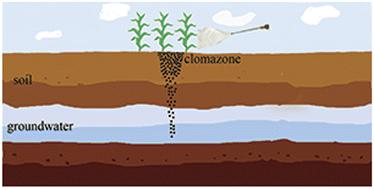当前位置:
X-MOL 学术
›
Environ. Sci.: Processes Impacts
›
论文详情
Our official English website, www.x-mol.net, welcomes your
feedback! (Note: you will need to create a separate account there.)
Characterization of the clomazone sorption process in four agricultural soils using different kinetic models
Environmental Science: Processes & Impacts ( IF 4.3 ) Pub Date : 2023-01-09 , DOI: 10.1039/d2em00272h Rada Ðurović-Pejčev 1 , Svjetlana Radmanović 2 , Zorica P Tomić 2 , Lazar Kaluđerović 2 , Tijana Đorđević 1
Environmental Science: Processes & Impacts ( IF 4.3 ) Pub Date : 2023-01-09 , DOI: 10.1039/d2em00272h Rada Ðurović-Pejčev 1 , Svjetlana Radmanović 2 , Zorica P Tomić 2 , Lazar Kaluđerović 2 , Tijana Đorđević 1
Affiliation

|
Kinetic studies are important for understanding the parameters and processes involved in the sorption of pesticides to soil. Considering the agricultural and environmental relevance of clomazone, its sorption kinetics was studied in four agricultural soils (Regosol, Planosol, Chernozem and Vertisol) at two concentrations (0.5 and 15 mg L−1). Different kinetic models were applied to the experimental data. The pseudo-second-order model described the data much better than the hyperbolic and pseudo-first-order models, and the kinetic rate constants indicated concentration-dependent clomazone sorption kinetics. The application of the two-site nonequilibrium model (TSNE) revealed a more time-dependent sorption of the lower clomazone concentration than that of the higher clomazone concentration, and the greatest concentration impact occurred in Regosol. Elovich and intraparticle diffusion models predicted more intensive sorption during the slower second phase and that sorption kinetics is governed more by mass transfer across the boundary layer than by a intraparticle diffusion process at higher clomazone concentration. Intraparticle diffusion is the rate-controlling process in Regosol at lower concentration, while this process and the boundary layer control the sorption kinetics in other soils. Significant correlations between some kinetic parameters and soil properties indicate an impact of the soil texture on the clomazone sorption mechanism, which must be considered in assessing the clomazone leaching behavior.
中文翻译:

使用不同的动力学模型表征四种农业土壤中异恶草酮的吸附过程
动力学研究对于了解农药吸附到土壤中所涉及的参数和过程非常重要。考虑到异恶草酮的农业和环境相关性,在两种浓度(0.5 和 15 mg L -1)下,在四种农业土壤(Regosol、Planosol、Chernozem 和 Vertisol)中研究了其吸附动力学). 不同的动力学模型被应用于实验数据。伪二级模型比双曲线和伪一级模型更好地描述了数据,动力学速率常数表明浓度依赖性异恶草酮吸附动力学。双位点非平衡模型 (TSNE) 的应用揭示了较低异恶草酮浓度的时间依赖性吸附比较高异恶草灵浓度的吸附更多,并且最大的浓度影响发生在 Regosol 中。Elovich 和颗粒内扩散模型预测在较慢的第二阶段吸附更强烈,并且吸附动力学更多地受边界层传质的控制,而不是较高异恶草酮浓度下的颗粒内扩散过程。颗粒内扩散是 Regosol 中较低浓度的速率控制过程,而该过程和边界层控制其他土壤中的吸附动力学。一些动力学参数与土壤特性之间的显着相关性表明土壤质地对异恶草灵吸附机制的影响,在评估异恶草灵浸出行为时必须考虑这一点。
更新日期:2023-01-09
中文翻译:

使用不同的动力学模型表征四种农业土壤中异恶草酮的吸附过程
动力学研究对于了解农药吸附到土壤中所涉及的参数和过程非常重要。考虑到异恶草酮的农业和环境相关性,在两种浓度(0.5 和 15 mg L -1)下,在四种农业土壤(Regosol、Planosol、Chernozem 和 Vertisol)中研究了其吸附动力学). 不同的动力学模型被应用于实验数据。伪二级模型比双曲线和伪一级模型更好地描述了数据,动力学速率常数表明浓度依赖性异恶草酮吸附动力学。双位点非平衡模型 (TSNE) 的应用揭示了较低异恶草酮浓度的时间依赖性吸附比较高异恶草灵浓度的吸附更多,并且最大的浓度影响发生在 Regosol 中。Elovich 和颗粒内扩散模型预测在较慢的第二阶段吸附更强烈,并且吸附动力学更多地受边界层传质的控制,而不是较高异恶草酮浓度下的颗粒内扩散过程。颗粒内扩散是 Regosol 中较低浓度的速率控制过程,而该过程和边界层控制其他土壤中的吸附动力学。一些动力学参数与土壤特性之间的显着相关性表明土壤质地对异恶草灵吸附机制的影响,在评估异恶草灵浸出行为时必须考虑这一点。









































 京公网安备 11010802027423号
京公网安备 11010802027423号